-
Countries
-
Data and Analysis
-
Special Focus
-
Crisis Responses
Assessment Report

Contact
DTM Europe, DTMMediterranean@iom.int
Language
English
Location
Bosnia & Herzegovina
Period Covered
Apr 01 2024
Apr 30 2024
Activity
- Flow Monitoring
This report provides insights into the profiles, experiences, needs, routes travelled and intentions of migrants transiting through Bosnia and Herzegovina (BiH). Data was collected from 1 to 30 April 2024. IOM carried out a route observation exercise in the Republika Srpska, Sarajevo Canton, Posavina Canton, Tuzla Canton, Bosnian-Podrinje Canton and Una Sana Canton to monitor trends in entries and exits as well as transit modalities within BiH. IOM also surveyed 553 migrants in active transit locations such as bus stops or at key entry and exit locations throughout the country as well as in four transit reception centres (TRCs) in BiH (Lipa, Ušivak, Borići and Blažuj).

Contact
DTM Sudan; dtmsudan@iom.int
Language
English
Location
Sudan
Period Covered
Apr 26 2024
May 08 2024
Activity
- Mobility Tracking
- Baseline Assessment
This report reflects data corresponding to Sudan Mobility Update (1) dataset. The dataset is available here.
Overview:
This report provides an overview of the total population of internally displaced persons (IDPs) in Sudan, including those displaced both before and after the onset of conflict on 15 April 2023.
The displacement crisis in Sudan has been unfolding for over two decades, with roots in the Darfur conflict beginning in 2003. Prior to the onset of conflict on 15 April 2023, Sudan already hosted an estimated 3,820,772 IDPs. The majority (80%) reportedly originated from Darfur states, and most were initially displaced between 2003 and 2010. Of these IDPs, many experienced secondary displacement after 15 April 2023. Since 15 April 2023, an estimated 7,111,788 individuals were displaced internally within Sudan — including those who experienced secondary displacement.
When accounting for those displaced both before and after 15 April 2023, DTM estimated that Sudan hosted a total of 9,957,655 IDPs.
Key Findings:
- An estimated total of 9,957,655 IDPs were displaced across 7,869 locations, in 183 localities in all 18 states in Sudan.
- An estimated 7,111,788 individuals were displaced internally within Sudan since 15 April 2023.
- An estimated 26 per cent of IDPs who were initially displaced prior to the onset of current conflict experienced secondary displacement since 15 April 2023.
- Approximately 2,111,791 individuals crossed borders into neighbouring countries since 15 April 2023.
- The top states of origin among IDPs were Khartoum (36%), South Darfur (21%), and North Darfur (12%).
- The states hosting the most IDPs were South Darfur (18%), North Darfur (13%) and Central Darfur (9%).
- Over half (56%) of IDPs were reportedly children under the age of 18-years-old.
Note: The number of IDPs displaced post 15 April 2023 (7,111,788 IDPs) includes the estimated 974,905 IDPs who were initially displaced prior to 15 April 2023 and experienced secondary displacement since 15 April 2023. DTM Sudan defines an internally displaced person as any person who has been forced or obliged to flee from their habitual residence due to an event dating from 2003 onwards.
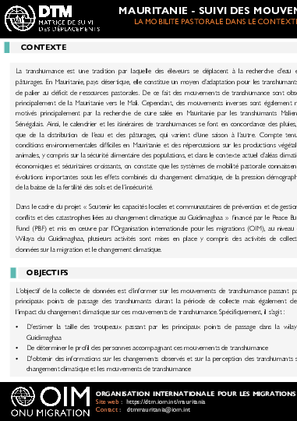
Contact
DTM Mauritania, DTMMauritania@iom.int
Language
French
Location
Mauritania
Period Covered
Feb 11 2024
May 07 2024
Activity
- Survey
- Flow Monitoring Survey
- Flow Monitoring
La transhumance est une tradition par laquelle des éleveurs se déplacent à la recherche d’eau et de pâturages. En Mauritanie, pays désertique, elle constitue un moyen d’adaptation pour les transhumants afin de palier au déficit de ressources pastorales. De ce fait des mouvements de transhumance sont observés principalement de la Mauritanie vers le Mali. Cependant, des mouvements inverses sont également notés, motivés principalement par la recherche de cure salée en Mauritanie par les transhumants Maliens ou Sénégalais. Ainsi, le calendrier et les itinéraires de transhumances se font en concordance des pluies, ainsi que de la distribution de l’eau et des pâturages, qui varient d’une saison à l’autre. Compte tenu des conditions environnementales difficiles en Mauritanie et des répercussions sur les productions végétales et animales, y compris sur la sécurité alimentaire des populations, et dans le contexte actuel d’aléas climatiques, économiques et sécuritaires croissants, on constate que les systèmes de mobilité pastorale connaissent des évolutions importantes sous les effets combinés du changement climatique, de la pression démographique, de la baisse de la fertilité des sols et de l’insécurité.
Dans le cadre du projet « Soutenir les capacités locales et communautaires de prévention et de gestion des conflits et des catastrophes liées au changement climatique au Guidimaghaa » financé par le Peace Building Fund (PBF) et mis en œuvre par l’Organisation internationale pour les migrations (OIM), au niveau de la Wilaya du Guidimaghaa, plusieurs activités sont mises en place y compris des activités de collecte de données sur la migration et le changement climatique.

Contact
DTM Mozambique, DTMMozambique@iom.int
Language
English
Location
Mozambique
Period Covered
Dec 05 2023
May 29 2024
Activity
- Mobility Tracking
- Site Assessment
This Multi-Sectorial Location Assessment (MSLA) report, which presents findings from the International Organization for Migration’s (IOM) Displacement Tracking Matrix (DTM) Round 13 assessments, aims to enhance understanding of the extent of internal displacements and the needs of affected populations in conflict-affected and disaster-affected districts of Mozambique. Data was collected between 5 - 29 December 2023 in close coordination with provincial government and Instituto Nacional de Gestão e Redução do Risco de Desastres (INGD) partners, and presents trends from 190 assessed sites hosting internally displaced persons (IDPs) across Northern (Cabo Delgado 95 sites, Nampula 2 sites, Niassa 7 sites), Central Mozambique (Sofala 36 sites, Manica 35 sites, Zambezia 10 sites, Tete 3 sites) and Southern (Inhambane 2 sites).
A total of 317,224 (IDPs were reported present in all 190 sites assessed. This represents a reduction of 19 per cent from MSLA Round 12. Reported figures, however, exclude displaced individuals living in host community settings. According to DTM Round 20 Mobility Tracking Report, as of August, an estimated 709,529 were identified living in both host communities and sites (582,764 IDPs in Northern Mozambique, and 126,765 IDPs in Central Mozambique).
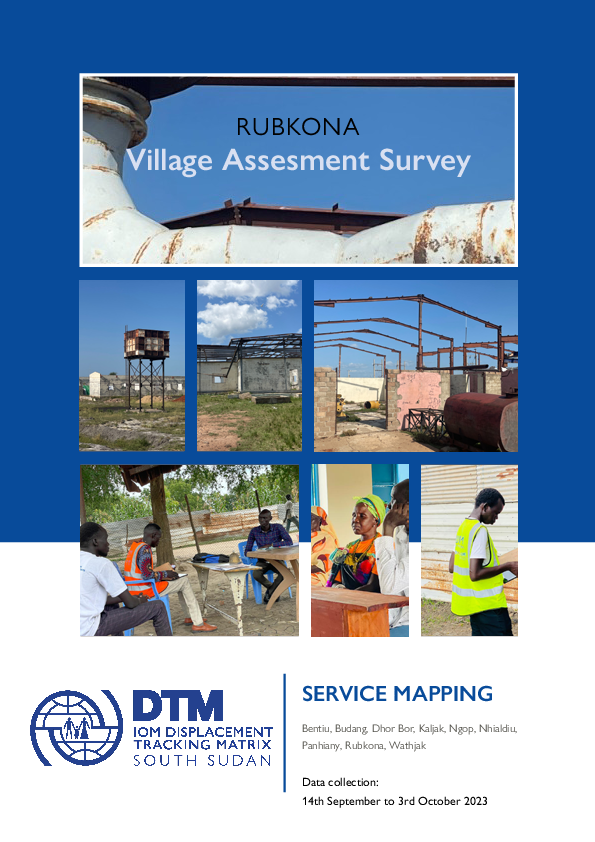
Contact
DTM South Sudan, SouthSudanDTM@iom.int
Language
English
Location
South Sudan
Period Covered
Sep 14 2023
Oct 03 2023
Activity
- Mobility Tracking
- Site Assessment
The data collection took place from September 14th, 2023, to October 3rd, 2023, covering a period of twenty days. The Displacement Tracking Matrix (DTM), a unit of the International Organization for Migration (IOM), conducted a 20-day Village Assessment Survey (VAS) in Rubkona County to assess transition and recovery needs. The survey focused on 09 Payam and 27 bomas accessible, as rainy season and flood limited access to some of the areas.
Of the 76 settlements assessed, 12 were found deserted while 64 remained populated. The survey meticulously mapped 240 facilities, 76 settlements, and 2 livelihood areas across the surveyed bomas. This includes 6 settlements in 6 bomas not assessed due to flooding. Among the 76-settlement identified, there are 37 neighborhoods, 30 permanent villages, 7 IDP sites and 2 temporary sites. The team managed to map 2 livelihood areas categorized into fishery grounds.
KEY FINDINGS
The assessment reveals a substantial number of destroyed or abandoned buildings, emphasizing the pressing need for housing reconstruction initiatives to address the housing crisis in the county.
Many areas within Rubkona County lack access to essential services such as education, healthcare, and markets, indicating a need for targeted interventions to improve service provision and overall community well-being.
In 67% of bomas, the fear of disasters, such as flooding, poses a substantial challenge for peaceful return, emphasizing the impact of environmental factors on human settlements.
A prevalent issue in multiple bomas across Rubkona County is the presence of individuals living on land/property without paying rent or obtaining permission from the owners, with 57% of bomas reporting such instances.
Most residential structures in Rubkona County lack permanency, characterized by the prevalence of temporary shelters such as tents and tukuls. These constructions are primarily composed of mud walls and thatched roofing, indicating a deficiency in durable and lasting housing infrastructure.
Critical need for improvements in school infrastructure, including insecure buildings, classroom shortages, insufficient furniture, and inadequate water and sanitation facilities, to create a conducive learning environment.
Urgent need for renovations, upgrades, and construction of permanent structures in healthcare facilities to ensure a safe environment for patients and healthcare workers.
The pressing need to rehabilitate non-operational boreholes to ensure a reliable water supply. the lack of water user committees in certain bomas inhibits local management of water resources.
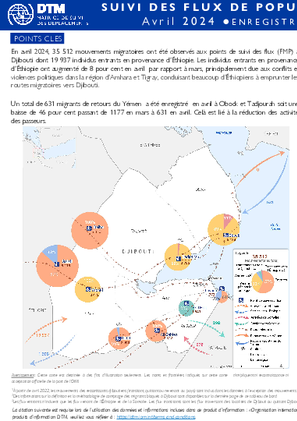
Contact
DTM Djibouti, DTMDjibouti@iom.int
Language
English
Location
Djibouti
Period Covered
Apr 01 2024
Apr 01 2024
Activity
- Flow Monitoring
En avril 2024, 35 512 mouvements migratoires ont été observés aux points de suivi des flux (FMP) à Djibouti dont 19 937 individus entrants en provenance d’Éthiopie. Les individus entrants en provenance d’Éthiopie ont augmenté de 8 pour cent en avril par rapport à mars, principalement due aux conflits et violences politiques dans la région d’Amhara et Tigray, conduisant beaucoup d’Éthiopiens à emprunter les routes migratoires vers Djibouti.
Un total de 631 migrants de retours du Yémen a été enregistré en avril à Obock et Tadjourah soit une baisse de 46 pour cent passant de 1177 en mars à 631 en avril. Celà est lié à la réduction des activités des passeurs.
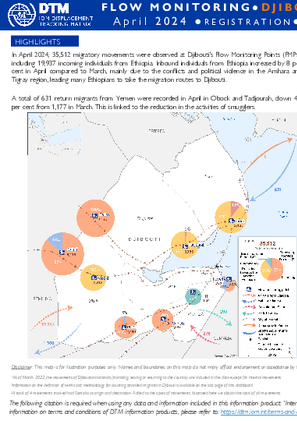
Contact
DTM Djibouti, DTMDjibouti@iom.int
Language
English
Location
Djibouti
Period Covered
Apr 01 2024
Apr 30 2024
Activity
- Flow Monitoring
In April 2024, 35,512 migratory movements were observed at Djibouti's Flow Monitoring Points (FMPs), including 19,937 incoming individuals from Ethiopia. Inbound individuals from Ethiopia increased by 8 per cent in April compared to March, mainly due to the conflicts and political violence in the Amhara and Tigray region, leading many Ethiopians to take the migration routes to Djibouti.
A total of 631 return migrants from Yemen were recorded in April in Obock and Tadjourah, down 46 per cent from 1,177 in March. This is linked to the reduction in the activities of smugglers.
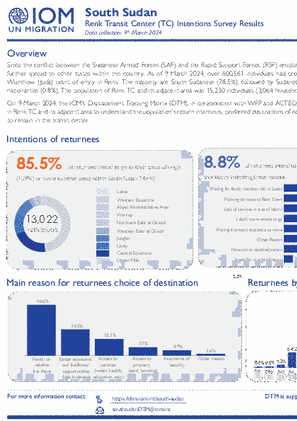
Contact
DTM South Sudan, SouthSudanDTM@iom.int
Language
English
Location
South Sudan
Period Covered
Mar 09 2024
Mar 09 2024
Activity
- Survey
- Return Intention
On 9 March 2024, the IOM’s Displacement Tracking Matrix (DTM), in collaboration with WFP and ACTED, conducted a rapid intention survey in Renk TC and its adjacent area to understand the population's return intentions, preferred destinations of return, as well as reasons for choosing to remain in the transit center.

Contact
DTM Yemen, iomyemendtm@iom.int
Language
English
Location
Yemen
Period Covered
Jul 29 2023
Sep 20 2023
Activity
- Survey
- Mobility Tracking
- Baseline Assessment
This summary presents the findings of the second round of Area Assessment (mobility Tracking) undertaken by IOM’s Displacement Tracking Matrix in its new format to establish a new baseline on the number of Internally Displaced Persons (IDPs), IDP returnees, and migrants in Yemen.
Findings are currently limited to the country’s south controlled by the internationally recognized government (IRG). Data was collected by 154 enumerators through extensive network of Key Informants (KIs) within the operational area. DTM deployed enumerators who are in regular communication with the KIs network throughout each month and work continuously to maintain and expand this network to further triangulate the displacement statistics collected. DTM field staff, along with KIs, use the Sub-Area Assessment tool to capture locations, which are matched to identified locations in the OCHA’s Common Operational Dataset (P-Codes).
This round 4,512 KIs were interviewed to collect the data, of whom seven per cent or 295 were females and 93 per cent were male. In a total of 403 sub-districts, IOM recorded a presence of IDPs in 372 sub-districts (92%), a presence of IDP returnees in 209 sub-districts (52%) and a presence of migrants in 79 sub-districts (20%).
In the Yemen context, the practice for field teams is to select KIs representatives of both the host and target communities while adhering to the humanitarian principles of humanity, neutrality, impartiality, and operational independence. This ensures that the selected KIs are the most relevant and appropriate individuals to ensure the successful implementation of the exercise. Among the main outputs of the sub-Area Assessment is a list of locations where IDPs, returnees, and/or migrants are present that can be used to inform more detailed assessments at the locations level, including the annual Multi-Cluster Location Assessment (MCLA). Using a standardized and structured approach to the selection of KIs is a key step to ensuring that data collected in Sub-Area Assessment is comprehensive and comparable across the different teams. The Sub-Area Assessment tool is used to verify and update the baseline information in regular intervals (round).
IOM DTM implemented round 39 area assessment in coordination with the Ministry of Planning and International Cooperation Central (MoPIC), Statistical Organization (CSO), and Executive Unit for IDP Camps Management (ExU) in 13 governorates under the Government of Yemen. The number of migrants indicated in this report represents a snapshot in time for a transient population located in areas data collection teams could access.

Contact
iomnigeriadtm@iom.int
Language
English
Location
Nigeria
Period Covered
May 06 2024
May 12 2024
Activity
- Other
On 7 May 2024, armed bandits attacked Sakajiki community in Kaura Namoda LGA, Zamfara State. The incident led to three fatalities and four injuries, affecting 219 homes and 1,097 individuals. Among the affected were 614 children, 259 women, and 224 men. The displaced population moved to neighboring communities within Kaura Namoda LGA, including Arewa, Shiyar Nafiu, and Sabon gari. The attack resulted in the destruction or severe damage of 40 shelters and the loss of many possessions of households.
Of all the needs identified, food and non-food items (NFIs) were the most prevalent. Other needs included security, shelter, and health services.
Following these events, DTM (Displacement Tracking Matrix) field staff conducted rapid assessments to inform the humanitarian community and Government/partners, and to enable a targeted response.
Nigeria’s north-central and north-west zones are afflicted with a multi-dimensional crisis. Long-standing tensions between ethnic and religious groups often result in attacks and banditry or hirabah. These attacks involve kidnapping and grand larceny along the major highways by criminal groups. During the past years, the crisis has intensified and has resulted in widespread displacements across the north-central and north-western regions.
Pagination
- Previous page
- Page 30
- Next page
